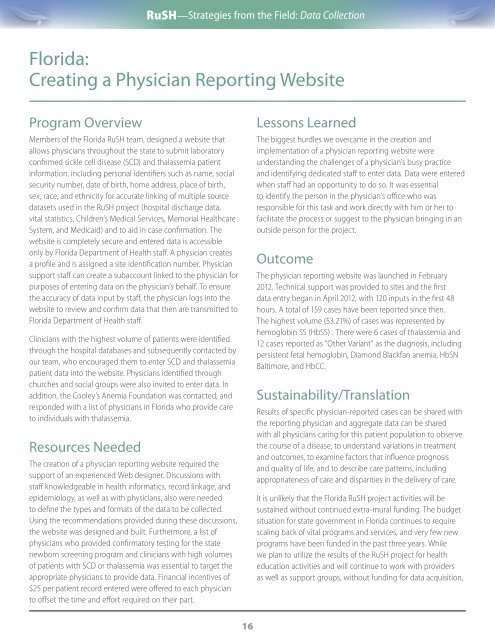RuSH: Strategies from the Field - Centers for Disease Control and ...
RuSH: Strategies from the Field - Centers for Disease Control and ...
RuSH: Strategies from the Field - Centers for Disease Control and ...
Create successful ePaper yourself
Turn your PDF publications into a flip-book with our unique Google optimized e-Paper software.
<strong>RuSH</strong>—<strong>Strategies</strong> <strong>from</strong> <strong>the</strong> <strong>Field</strong>: Data Collection<br />
Florida:<br />
Creating a Physician Reporting Website<br />
Program Overview<br />
Members of <strong>the</strong> Florida <strong>RuSH</strong> team, designed a website that<br />
allows physicians throughout <strong>the</strong> state to submit laboratory<br />
confirmed sickle cell disease (SCD) <strong>and</strong> thalassemia patient<br />
in<strong>for</strong>mation, including personal identifiers such as name, social<br />
security number, date of birth, home address, place of birth,<br />
sex, race, <strong>and</strong> ethnicity <strong>for</strong> accurate linking of multiple source<br />
datasets used in <strong>the</strong> <strong>RuSH</strong> project (hospital discharge data,<br />
vital statistics, Children’s Medical Services, Memorial Healthcare<br />
System, <strong>and</strong> Medicaid) <strong>and</strong> to aid in case confirmation. The<br />
website is completely secure <strong>and</strong> entered data is accessible<br />
only by Florida Department of Health staff. A physician creates<br />
a profile <strong>and</strong> is assigned a site identification number. Physician<br />
support staff can create a subaccount linked to <strong>the</strong> physician <strong>for</strong><br />
purposes of entering data on <strong>the</strong> physician’s behalf. To ensure<br />
<strong>the</strong> accuracy of data input by staff, <strong>the</strong> physician logs into <strong>the</strong><br />
website to review <strong>and</strong> confirm data that <strong>the</strong>n are transmitted to<br />
Florida Department of Health staff.<br />
Clinicians with <strong>the</strong> highest volume of patients were identified<br />
through <strong>the</strong> hospital databases <strong>and</strong> subsequently contacted by<br />
our team, who encouraged <strong>the</strong>m to enter SCD <strong>and</strong> thalassemia<br />
patient data into <strong>the</strong> website. Physicians identified through<br />
churches <strong>and</strong> social groups were also invited to enter data. In<br />
addition, <strong>the</strong> Cooley’s Anemia Foundation was contacted, <strong>and</strong><br />
responded with a list of physicians in Florida who provide care<br />
to individuals with thalassemia.<br />
Resources Needed<br />
The creation of a physician reporting website required <strong>the</strong><br />
support of an experienced Web designer. Discussions with<br />
staff knowledgeable in health in<strong>for</strong>matics, record linkage, <strong>and</strong><br />
epidemiology, as well as with physicians, also were needed<br />
to define <strong>the</strong> types <strong>and</strong> <strong>for</strong>mats of <strong>the</strong> data to be collected.<br />
Using <strong>the</strong> recommendations provided during <strong>the</strong>se discussions,<br />
<strong>the</strong> website was designed <strong>and</strong> built. Fur<strong>the</strong>rmore, a list of<br />
physicians who provided confirmatory testing <strong>for</strong> <strong>the</strong> state<br />
newborn screening program <strong>and</strong> clinicians with high volumes<br />
of patients with SCD or thalassemia was essential to target <strong>the</strong><br />
appropriate physicians to provide data. Financial incentives of<br />
$25 per patient record entered were offered to each physician<br />
to offset <strong>the</strong> time <strong>and</strong> ef<strong>for</strong>t required on <strong>the</strong>ir part.<br />
16<br />
Lessons Learned<br />
The biggest hurdles we overcame in <strong>the</strong> creation <strong>and</strong><br />
implementation of a physician reporting website were<br />
underst<strong>and</strong>ing <strong>the</strong> challenges of a physician’s busy practice<br />
<strong>and</strong> identifying dedicated staff to enter data. Data were entered<br />
when staff had an opportunity to do so. It was essential<br />
to identify <strong>the</strong> person in <strong>the</strong> physician’s office who was<br />
responsible <strong>for</strong> this task <strong>and</strong> work directly with him or her to<br />
facilitate <strong>the</strong> process or suggest to <strong>the</strong> physician bringing in an<br />
outside person <strong>for</strong> <strong>the</strong> project.<br />
Outcome<br />
The physician reporting website was launched in February<br />
2012. Technical support was provided to sites <strong>and</strong> <strong>the</strong> first<br />
data entry began in April 2012, with 120 inputs in <strong>the</strong> first 48<br />
hours. A total of 159 cases have been reported since <strong>the</strong>n.<br />
The highest volume (53.21%) of cases was represented by<br />
hemoglobin SS (HbSS) . There were 6 cases of thalassemia <strong>and</strong><br />
12 cases reported as “O<strong>the</strong>r Variant” as <strong>the</strong> diagnosis, including<br />
persistent fetal hemoglobin, Diamond Blackfan anemia, HbSN<br />
Baltimore, <strong>and</strong> HbCC.<br />
Sustainability/Translation<br />
Results of specific physician-reported cases can be shared with<br />
<strong>the</strong> reporting physician <strong>and</strong> aggregate data can be shared<br />
with all physicians caring <strong>for</strong> this patient population to observe<br />
<strong>the</strong> course of a disease, to underst<strong>and</strong> variations in treatment<br />
<strong>and</strong> outcomes, to examine factors that influence prognosis<br />
<strong>and</strong> quality of life, <strong>and</strong> to describe care patterns, including<br />
appropriateness of care <strong>and</strong> disparities in <strong>the</strong> delivery of care.<br />
It is unlikely that <strong>the</strong> Florida <strong>RuSH</strong> project activities will be<br />
sustained without continued extra-mural funding. The budget<br />
situation <strong>for</strong> state government in Florida continues to require<br />
scaling back of vital programs <strong>and</strong> services, <strong>and</strong> very few new<br />
programs have been funded in <strong>the</strong> past three years. While<br />
we plan to utilize <strong>the</strong> results of <strong>the</strong> <strong>RuSH</strong> project <strong>for</strong> health<br />
education activities <strong>and</strong> will continue to work with providers<br />
as well as support groups, without funding <strong>for</strong> data acquisition,

















